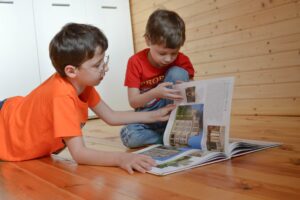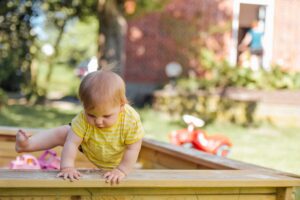Hands-On Learning
It’s a bright and sunny Saturday morning and your young daughter is eager to help you wash dishes after breakfast. You’re wiping down counters and she’s happily humming away as she gets the plates sudsy. After she washes them off, she sets them on the rack by the sink to dry. You may not think of it at the moment, but your child is demonstrating the Montessori principle of hands-on learning.

What is the Montessori Principle of Hands-On Learning?
The Montessori principle of hands-on learning is the idea that children need tangible, physical experiences to best learn about the world around them. Active, hands-on learning is the best way for children to retain knowledge. Maria Montessori firmly believed in the importance of a child engaging both their hands and their mind to grasp a concept. That’s because hands-on learning, or whole child education, immerses a child both intellectually and emotionally in the learning process.
Why Active Learning Works Best
Maria Montessori believed in the value of active learning for young children because it connects their learning with tangible, real-world experiences. As the name suggests, children learn the most when they are actively engaged. Active learning encourages children to ask questions and get involved in the learning process.
For example, a child starts exploring a particular subject and then ends up in a completely different place. For instance, maybe your child is interested in Japan. First, they learn all about Japanese history and culture. They then find themselves exploring the snow monkey, which is indigenous to Japan.
is interested in Japan. First, they learn all about Japanese history and culture. They then find themselves exploring the snow monkey, which is indigenous to Japan.
While studying the natural habitats of snow monkeys, the child then progresses into the field of conservation biology. Next, they scaffold their learning with the study of other endangered species in the world. The learning progresses organically. It’s hard to achieve that in a traditional classroom setting with the standard separation of subjects and a strict curriculum that must be followed.
The Difference Between Active and Passive Learning
Passive learning is when the child’s education takes place independently of real-world experiences. Passive learning is exactly like it sounds. It usually comes in the form of lectures, reading, watching videos, and memorizing information. Passive learning is hands-off, conceptualized learning, and it’s not appropriate for young children. To get a good visual, this graph shows the value of active learning at any age, from preschool through higher education.
Even though your child might feel dependent on manipulatives to learn a math concept, that’s as it should be. Children need experiences to teach them about abstract concepts. The Montessori principle of hands-on learning is an integral part of the Montessori method. Your child instinctively recognizes the value in it. As a facilitator, you provide your child with what they need. Then, like a compass, their internal motivation guides their learning.
The 4 Stages of Development and What They Mean for the Montessori Principle of Hands-On Learning
To understand the Montessori principle of hands-on learning, it’s important to know about the four stages of development. According to Association Montessori International, every person must pass through the four stages of development to reach maturity. Those stages are:
- Physical and biological independence (birth to age 6)
- Mental independence (age 6 to 12)
- Social independence (age 12 to 18)
- Spiritual and moral independence (age 18 to 24)
Between birth and age 6, children begin in the absorbent mind stage. This is the period of life that children build the foundation of their knowledge. At this stage of development, they soak up knowledge like a sponge. Hence the term “absorbent mind.” When you break it down even further, you have the unconscious absorbent mind, which lasts from birth to age 3. Finally, the conscious absorbent mind, which takes place from age 3 to about 6.
The Montessori Principle of Hands-On Learning in the Absorbent Mind Stage
 During the unconscious absorbent mind stage, children are learning how to sit, balance, and eventually walk and talk all by watching the world around them. They learn quickly and intuitively because their brains are hard-wired to learn through movement and practice. As you’ve probably heard, this is the best time to teach a child a foreign language because they will pick it up so much more effortlessly than an adult would. That’s the beauty of the absorbent mind.
During the unconscious absorbent mind stage, children are learning how to sit, balance, and eventually walk and talk all by watching the world around them. They learn quickly and intuitively because their brains are hard-wired to learn through movement and practice. As you’ve probably heard, this is the best time to teach a child a foreign language because they will pick it up so much more effortlessly than an adult would. That’s the beauty of the absorbent mind.
The conscious absorbent mind stage involves more deliberate learning. And what better way to learn than actually doing? That’s where the Montessori principle of hands-on learning comes into play. It’s during these formative years that all children build foundational knowledge through active learning. They make sense of their world through the natural order of things and have an intrinsic desire to learn.
Putting the Montessori Principle of Hands-On Learning Into Practice
Now that you know hands-on learning is absolutely paramount for a child’s developing mind, you can put it into practice. Here are a few ideas to help you get thinking about how to organize your at-home Montessori environment:
Cultural Studies
- Wooden map puzzles of countries
- Interesting items from countries around the world
Science
- Sketching animals in their habitat
- Engaging in science experiments
Math
- Bead frames
- Lego blocks
- Sandpaper numbers
Language Skills
- Sequencing cards
- Movable alphabet
- Learning language toolbox
Fine Motor Skills
- Lacing card printable
- Seasonal art projects
- Gluing, drawing, tracing, cutting
Practical Life Skills
- Helping hands toolbox
- Pouring and scooping practice
- Working alongside parents with daily chores
With the Montessori principle of hands-on learning, it’s exciting to witness your child put the practice into action. It’s amazing to watch them become deeply absorbed in intense concentration while working on a project or seeing how they get excited over a particular activity. It’s truly a beautiful thing to witness your child expand their knowledge based on pure interest, and then light up inside with something that sparks their imagination.
When Maria Montessori said that “play is the work of the child,” she knew exactly what she was talking about. Play is where the learning process happens naturally. All you need to do is give your little one a custom-made environment and the freedom to explore to their heart’s content.




0 Comments